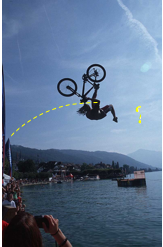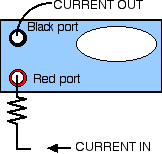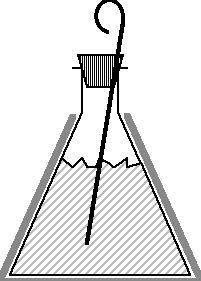|
|
| In this newsletter: |
| |
Message from the VIP president
VIP Meeting agenda
Charged Coffee Creamer: Demo
Projectile Motion (Computer Investigation Homework)
Kirchoff’s Lab
Capacitance Lab |
by Tony Wayne
by Tony Wayne
by Andy Jackson
by Harold Houghton
by Harold Houghton |
The VAST conference was great! VIP’s contribution of presentations was enjoyed by all. Now is the time to look forward to the spring meeting. It is coming fast! Unfortunately after one year as president I’m going to have to step down. My new responsibilities as department chair and math and science academy coordinator as well as teaching a full load have become much more demanding that what I was told. Because of this, I find it difficult to lead VIP too. I’m sure we will find someone who can continue to lead VIP as a professional organization at our next meeting.
-Tony Wayne |
 |
VIP/VAST Spring Meeting Information
Who: Physical Science teachers and Physics teachers and professors
When: April 19th (time agenda below) 8:30 – 4:00
Where: the physics building, Jesse Beams Laboratory. There is a good web map at http://www.virginia.edu/webmap/. Click on “G” The physics building is #41. You may want to park behind #38 off of stadium road. Do not park at the physics building. This is 24/7 permit parking.
Why: ‘Cause it’s a fun way to become better at what you do!
Cost: Free!!!
Sponsor: This meeting is hosted by the Physics Department of the University of Virginia and supported by funds from the Virginia Association of Science Teachers.
RSVP IF ATTENDING – FIRST 24 GUARANTEED MAKE AND TAKE EQUIPMENT – twayne[at symbol]k12albemarle.org
Agenda
8:30 – 9:00 Hellos and Juice, Coffee, and Danish
9:00 –10:00 Business and election of officers
10:00 – 11:30 Share Session – bring an idea and 35 copies the write up to share! (Bring ideas on what to do with a hand held Tesla coil.)
12:45 – 4:00 Make and Take on “Electrostatics and magnetism”
Bring a lesson, idea, piece of equipment- bring a friend! We will head to local restaurants for lunch together (but as far as cost – you’re on your own) |
 |
Presenter: Tony Wayne
Albemarle High School , twayne[at symbol]k12albemarle.org
Va. SOL:
PH.12 The student will investigate and understand how to use the field concept to describe the effects of electric, magnetic, and gravitational forces.
Topic/Concept
A force is needed to move any object.
Force fields.
Electrostatic repulsion
Materials
1 container of powdered coffee creamer
10 plastic spoons
10 8 inch long pieces of PVC pipe
10 3inch b 3 inch squares of rabbit fur.
Safety Considerations
Warn students not to get his or hers face too close to the spoon full of creamer.
Presentation
- Pair the students up in small groups. Each group gets 1 PVC pipe, 1 rabbit fur piece, and a heaping, plastic, spoon full of powdered coffee creamer.
- Instruct students to rub the pipe and fur for about 4 seconds.
- Touch the pipe to the underside of the spoon. Slowly move the pipe back and forth while keeping contact with the spoon.
- Write down your observations and inferences.
- Convene the large group. Discuss their observations and then inferences. Most will say the powdered creamer is repelled by the pile of creamer. Ask what make it move. Try to cajole them to describe that to move a grain of creamer off the pile require a force. Ask further where the force comes from. It comes from a force field.
- Have student hold the charged pipe near the arms and ask if they feel anything as the pipe is moved around. (Their arm hair should stand up and they should feel it move.) Tell them their arm is in a force field. And this force field applies a force to charged objects like the hair on their arms.
- The purpose of get them to think about the mechanism behind the 8th grade rule of, Opposites attract and likes repel. I emphasize the force field concept for the whole unit.
- At the end of the unit we revisit the coffee creamer and I ask how they repeat the experiment and change the experiment such that when the charged pipe is brought close to the spoon, the powdered coffee creamer does not jump off the spoon. Then I get them to try their ideas.
How the physics is demonstrated
The pile of coffee creamer gets a charge from the charged pipe. The pile exerts an electric field. This field pushes the loose grains of charged creamer upwards. Now this is where the idea of, likes repel, comes from.
Teacher Tips Regarding Lab
- Dont place your face or any of your students faces near the creamer when it is charged. It could jump into your eye.
- Tell students not to blow it into anybodys eyes while they are making observations
- Dont use the coffee creamer in your coffee after the kids have finished the experiment. It may taste like your lab table. Remember, It is not stylish to drink a latte with a hint of lab table on the top.
Sources & References - None |
|
 |
by Andy Jackson
This "Computer Investigation Homework" takes advantage of two facts- all of my students have access to the internet outside of class time either at home or the library and there is an increasing number of quality internet based simulations for physics. This Computer Investigation Homework allows the student to explore the concepts associated with projectile motion that, in the past, I used to present and lecture on in class. I started with chalk and talk and then moved to computer with projected simulations that supported my lecture. This tool has several advantages over both of those models in my opinion. This particular applet is fun and engaging and so the student will be drawn in to play with it. By assigning it as home work, the student will most likely work on it individually and will move at the pace that is right for him or her without worrying about other students or about me moving along to quickly or slowly. The CIH is one homework assignment that saves me instructional time. Students can and do pick up this information better this way than with me lecturing. Therefore I can use the class time for more difficult concepts. The nature of the majority of the questions on the CIH are such that a student who can understand the directions and the simulation controls can answer the questions. Question #7 and the last part of question #3 are questions that move into higher levels of thought, and are phrased in a way that I can give full credit for valiant efforts and also have a glimpse into how the student is thinking about the mechanics of projectile motion. After students complete this, they have had a good exposure to the nature of projectile motion and all have a good set of common experiences on which to build computational work. |
 |
| Projectile Motion -Computer Investigation Homework |
 |
| by Andy Jackson |
| Go to http://www.mhhe.com/physsci/physical/giambattista/proj/projectile.html |
Click Go to make the motorcycle jump. Use the show axis tool to measure the greatest distance he can jump at a take off speed of
8.0 m/s.
1. What was the riders greatest distance?____________________ What angle accomplished this?_____
2. What combination of angle and speed allows the rider to land safely in the sandbags?
3. Is it possible to do this with a significantly different angle? If so, what values work? If so, how do two different sets of values result in the same landing spot?
4. Put the velocity at 7.5 m/s and use the show axis tool to record how long the jump is at the following angles. Be consistent and measure the distance to the riders foot. |
| Describe and trends or patterns you see in the data. |
|
Angle
(degrees) |
Distance
(m) |
20 |
|
25 |
|
30 |
|
35 |
|
40 |
|
45 |
|
50 |
|
55 |
|
60 |
|
|
| 5. Set the velocity to 7.0 m/s with a take off angle of 45 degrees. Use the pull down menu to turn on both velocity and acceleration vectors. Use the step button to move the motorcyclist through the jump and observe the values and directions of the various vectors. Briefly describe each vector through the jump. |
| Acceleration |
Vertical Velocity |
| Horizontal Velocity |
Total Velocity |
|
Click on the radio button for the “Archer” game.
Adjust the “angle” slider. You will see the cross-hairs move up and down the tree. Adjust and click “Go” until you can hit the coconut.
Adjust the starting height of the monkey and coconut and try again.
6. Where do you have to aim in order to hit the coconut?
|
Turn on the acceleration and velocity vectors and use the step button to analyze the motion.
7. Explain why you need to aim the way you do to hit the coconut. |
|
 |
 |
For each of the following circuits you will measure the current through and the voltage drop across each of the resistors and enter it in the associated table. Remember that a voltmeter is attached in parallel with a resistor to find the voltage drop across the resistor. An ammeter is attached in series with the resistor so that the same current goes through it and the resistor. Unfortunately our ammeters have relatively large resistances and would change the circuit radically if they were added so we will include them permanently and call the combination of a resistor and its ammeter one resistance.
On the diagram, draw arrows next to each resistor to indicate the direction you expect the current to flow.
Assemble the indicated circuit with a meter-resistor combination for each resistor shown in the diagram and the current
flowing in at the red port.
Let your instructor look at your circuit before turning on the power. |
Turn the power dial to its lowest setting, switch on the source and then slowly increase the dials until none of the currents are greater than 400 uA DISPLAY
If any dials have the needle deflected to the left, you must change the direction of the arrow in the diagram and in your subsequent reasoning.
Find the voltage drop across each resistor-meter combination (probes at black port and far end of resistor)
Read the current through each of the resistors on the meters display. Also find the voltage gain across sources of emf. (If you pull the plugs out slightly, you can reach them with the voltmeter while they're still connected.) |
 |
|
Using Kirchhoff's rules go around circuits show your work in the spaces provided to find what the current and voltage through the third resistor should have been. If your looping takes across a source of emf backwards( from - to + (aka long to short) then it counts as a voltage drop, if you cross a resistor against the direction of the current then it is a voltage gain.
As you finish with one set-up, disconnect one of the wires at the source BEFORE you switch it off. Just this first time, as you switch the power off, keep your voltmeter across a source of emf and you will observe the voltage INCREASE dramatically and then slowly fade. Clearly there is a source of emf even when the source is unplugged.
Describe this mystery source of emf below: |
|
FIRST |
emf 1 |
emf 2 |
Resistor 1 |
Resistor 2 |
Resistor 3 measured |
Resistor 3 calcululate |
Percent Error relative to R1 calc |
 |
I |
xxxxx |
xxxxx |
|
|
|
|
|
V |
|
xxxxx |
|
|
|
|
|
|
In this circuit there are no junctions so an application of Kirchhoff’s junction would yield: I1 = I2 = I3 So I3-calculated should equal I1 or I2. You can choose.
Show your work using Kirchhoff's loop rule to calculate V3 using the loop containing R1 and R3. I’d like you first to symbolically write: emf1 – V3 – V2 – V1 = 0 and then substitute values to solve for V3. |
SECOND |
emf 1 |
emf 2 |
Resistor 1 |
Resistor 2 |
Resistor 3 measured |
Resistor 3 calcululate |
Percent Error relative to R1 calc |
 |
I |
xxxxx |
xxxxx |
|
|
|
|
|
V |
|
xxxxx |
|
|
|
|
|
|
Show your work using Kirchhoff's junction rule to calculate I3
Show your work using Kirchhoff's loop rule to calculate V3 using the loop containing R1 and R3
Show your work using Kirchhoff's loop rule to calculate V3 using the loop containing R2 and R3. If this result is different from the one above, use the best one as V3-calculated.
|
THIRD |
emf 1 |
emf 2 |
Resistor 1 |
Resistor 2 |
Resistor 3 measured |
Resistor 3 calcululate |
Percent Error relative to R1 calc |
 |
I |
xxxxx |
xxxxx |
|
|
|
|
|
V |
|
|
|
|
|
|
|
|
Show your work using Kirchhoff's junction rule to calculate I3
Show your work using Kirchhoff's loop rule to calculate V3 using the loop containing R1 and R3.
Show your work using Kirchhoff's loop rule to calculate V3 using the loop containing R2 and R3. Note that you’ll be getting two results from this work and the work above. You can use the one you like best or an average for calculated.
|
FOURTH |
emf 1 |
emf 2 |
Resistor 1 |
Resistor 2 |
Resistor 3 measured |
Resistor 3 calcululate |
Percent Error relative to R1 calc |
 |
I |
xxxxx |
xxxxx |
|
|
|
|
|
V |
|
|
|
|
|
|
|
|
Show your work using Kirchhoff's junction rule to calculate I3
Show your work using Kirchhoff's loop rule to calculate V3 using the loop containing R1 and R3
Show your work using Kirchhoff's loop rule to calculate V3 using the loop containing R2 and R3. Again you have a choice. |
 |
Capacitance Lab NO PRE-LAB name_________________________
The purpose of this lab is for you to have an opportunity to experience first-hand, the construction and operation of a capacitor.
LEYDEN JAR
- Put about 100ml of salt water in an Erlenmeyer flask.
- Place the flask on a 10cm X 10 cm square of aluminum foil and fold the foil around the sides of the flask.
- Put one end of the copper wire provided into the salt water.
- Connect the base of the Van de Graf generator to the copper wire coming out of the flask and hold the aluminum foil against the globe at the top of the Van de Graf generator for about 10 seconds.
- Disconnect the wire from the base, return to your seat, and set the aluminum wrapped flask on your table. Over the course of the next half minute touch first the aluminum foil only and then stop touching the aluminum and touch the copper wire only. Note that these actions would normally cause grounding (neutralization or loss of charge).
- NOW fold down you middle three fingers, touch the aluminum with your pinkie and while it remains in contact with the aluminum bring your thumb over to make contact with the copper wire. If there is not a noticeable shock then we need to try again.
- Everyone in your group is to have the experience of discharging the capacitor.
- QUESTIONS
- List the ions found in salt water with their charges. (leave out ions from the water)
|
2. Assume the aluminum foil gained a negative charge from the Van de Graf generator and the copper wire has a positive charge. Based upon these statements sketch a probable distribution of the ions inside of the flask. Indicate the location of at least 4 of each ion.
|
 |
3. Describe the process of neutralization which normally would have taken place when one touches a negatively charged object.
|
4. Why wasn't the foil neutralized by your touch in this instance?
|
| |
|
Please help us keep our mailing list current!
Please send any address or name corrections to twayne[at symbol]k12albemarle.org
Please put VIP mail in the subject line and tell me what to change. If you are receiving multiple copies, let us know what address to delete. If it comes to you with someone else’s name on it – just drop me a line.
I don't know what's the matter with people: they don't learn by understanding, they learn by some other way — by rote or something. Their knowledge is so fragile!
Richard Feynman from Surely You’re Joking, Mr. Feynman. |